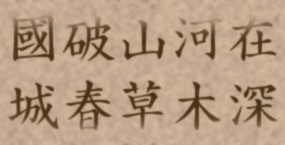Tips for reading and translating Chinese Tang poetry
These are a few tips from the staff of the Chinese faculty at Cambridge on tackling Tang / Song poetry.
Determine where each line splits
Tang poetry is famous for its use of 律詩 - ‘regulated verse’. This dictates the length of each line (e.g. five characters) and where each line ‘splits’. Usually each line in a poem will split into two halves, and the point in the line where the split occurs is maintained throughout the poem. This pattern may also be broken for effect.
To understand each line it’s important to consider the split and treat the line as two halves. This will often disambiguate a line, or reveal a meaning that would not have been apparent otherwise.
Look for parallelism
This is a central feature of Tang poetry. Lines frequently come in couplets with mirrored structures, and this is essential to understanding them. For example, a couplet may use the same sequence of nouns and verbs in each line. Frequently, the final two lines will form a ‘break’ by avoiding parallelism, bringing a powerful conclusion to the poem. Du Fu in particular favoured this technique.
Establishing that two lines are parallel is often very helpful in determining their meaning, as it demonstrates the role of each character in the couplet.
Look for antithesis
Parallelism in Tang poetry nearly always involves antithesis as well as mirrored structures. Couplets may use opposite or contrasting meanings in each position, or offset different concepts to bring out more meaning. Again, spotting this and incorporating it into a reading is often useful for getting the real sense of the original.
Use a literal gloss (‘trot’)
It’s often helpful to write out a literal character-by-character translation of a line. Sticking to one key word that best captures the meaning of each character (in its context in the poem) is likely the most effective technique. This helps to keep close to the original meaning of the Chinese, and avoid inserting extra words to ‘make sense’ of the poem.
Ideally, the literal gloss can be converted into a grammatical English sentence by simply inserting function words, but this is often not quite possible, or results in very awkward translations. Keeping close to the gloss is still a good aim, though.
Spot ‘empty’ characters
These are fairly rare in Tang poetry, but sometimes appear to conform to the requirements of 律詩. They add little or nothing to the meaning of the line, but maintain the breaking pattern or line length. Common choices are 一 and 以, but any character can be looked at in this way. It can be tempting to dismiss problem characters as ‘empty’ though, so it’s best to include the meaning of every character as much as possible.
Avoid being too analytical
Tang poetry does not give a great deal of text to work on. It’s very efficient, elegant and compact, and this makes it tempting to read a lot of information from between the lines. Whilst this is may be necessary to fully appreciate the poem, a true reading and translation should probably try to maintain the simplicity and subtlety of the original.
Stick to what’s there
This is closely related to the point above. As far as possible, a translation should only contain the concise wording of the original, and function words. No new content words should be included. It may be better for a translation to sound slightly stilted in order to avoid inserting information that isn’t there in the Chinese.

